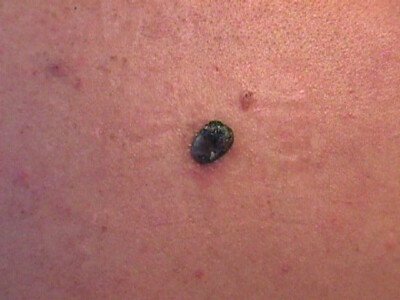

Characteristics: Fibrous tissue (or scar tissue) that forms following injury to the skin forms a protective scar which can grow excessively to form a smooth, hard growth.Removal is done with an injected local anaesthetic and a small incision (cut into the skin) directly over the growth. A growth can also develop again if not completely removed. A medical doctor should perform removal, ensuring that the procedure is safely done without risk of infection or bleeding. A growth should never be removed at home. those that are internal) may require testing to determine other possible abnormalities associated with various conditions, such as CT scans or scope procedures (and other imaging procedures). Rarer forms of dermoid cysts may require removal using special techniques. Growths which occur on the surface of the skin (often termed ‘superficial’) can mostly be removed surgically without complications. If a cyst increases in size or changes colour, a doctor must assess the growth, which will most likely be treated with surgical removal as well. Inflammation and rupture of these growths can be accompanied by fever. They can also become inflamed and painful, and removed for this reason too. Diagnosis and treatment: These growths can be unsightly and for this reason alone, may be safely removed.The slow growth of these cysts means that they are often only noticed in early childhood and even adulthood.

The cell walls of these structures are almost identical, containing hair follicles, sweat glands and even nerves. Cause: During foetal development the skin and multiple skin structures become trapped.These growths have also been known to develop, although rarely, in the brain, nasal sinuses, the eyes or spinal cord. The growths are normally firm to the touch and painless (unless they break open). The growths typically develop slowly and can become tender to the touch when broken open (or ruptured). A growth that develops internally can even contain bone fragments, cartilage or teeth. Characteristics: These saclike growths are often present at birth on the surface of the skin (usually the face, lower back, in the ovaries or even inside the skull) and are made up of hairs, sweat glands, sebaceous glands and fluid.Dermatofibromas can be surgically removed for cosmetic reasons or if they become bothersome due to itchiness or pain, and especially if they begin changing colour, grow larger or bleed. These growths are usually harmless, but can be assessed through biopsy analysis if a doctor feels it necessary to differentiate it from other conditions. Sometimes this action can cause it to dimple. Diagnosis and treatment: A doctor may apply lateral pressure to the growth.Cause: These growths may form as multiples or as solitary lesions, often developing spontaneously following a minor trauma to the skin (for instance an insect bite).These growths are common among women, but are not unusually experienced in children or teenagers. Dermatofibromas can sometimes be itchy or painful to the touch, but are predominantly asymptomatic (displaying no noticeable symptoms). Sometimes, these growths can ‘retract’ forming a dimple in the area. Occasionally, these growths can develop a little larger. The overlaying epidermis (layer of skin) is slightly thickened and ranges between 0.5 and 1.5 centimetres in diameter. Characteristics: Dermal nodules (small and firm flesh-coloured, dusky red, brown or black coloured bumps) develop as a result of accumulated fibroblasts (soft tissue cells beneath the skin’s surface).Some of the most common types of non-cancerous (controlled or benign) skin growths which can develop include: Dermatofibromas It is not uncommon for a variety of different marks, such as moles and freckles, to develop as a result of sun exposure too. Skin changes with age are common for most people. When should I worry about a marking on my skin?Ĭommon types of benign (non-cancerous) skin growths.
/57304376-56a0e5ed3df78cafdaa62f31.jpg)


 0 kommentar(er)
0 kommentar(er)
